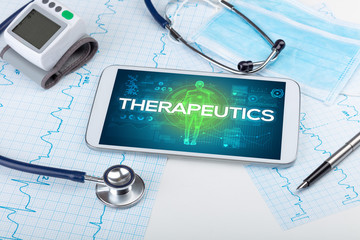Digital Therapeutics- A new age digital medicine
Read Time 5 mins | Written by: Anuj Kharnal

What is Digital Therapeutics?
Digital therapeutics (DTx) is the use of digital technologies, such as software or mobile applications, to improve or maintain the health of individuals. These technologies are designed to provide evidence-based interventions that can be used to treat or manage a variety of medical conditions, including mental health disorders, chronic diseases, and infectious diseases.
Digital therapeutics can be used alone or in combination with other forms of treatment, such as medication or therapy, to address a range of health issues. They can be used to deliver personalized care, provide support and guidance to patients, and track progress over time. Some examples of digital therapeutics include apps that help people manage their diabetes, virtual reality programs for treating anxiety and depression, and software programs that help people quit smoking.
Digital therapeutics are increasingly used in healthcare settings and are becoming an essential part of the treatment landscape. They offer several potential benefits, including increased accessibility and convenience for patients, the ability to provide ongoing support and monitoring, and the potential to lower healthcare costs. However, it is important to note that DTx interventions are designed to support and complement traditional healthcare, not to replace it. While DTx interventions can be effective in helping individuals manage their health and prevent or treat medical conditions, they are not intended to replace the role of healthcare professionals in the diagnosis and treatment of medical conditions.
Additionally, digital therapeutics is still a relatively new field and more research is needed to fully understand their effectiveness and appropriate use.
Digital Health and DTx
Digital health is a broader term that encompasses all aspects of healthcare that are enabled by digital technologies. This includes DTx interventions, as well as other digital tools and technologies that support the delivery and management of healthcare, such as telemedicine, electronic health records (EHRs), and health information exchange systems.
While DTx and digital health are both related to the use of technology in healthcare, they refer to different aspects of this field. DTx specifically refers to the use of digital and software-based interventions to prevent, manage, or treat medical conditions, while digital health encompasses all aspects of healthcare that are enabled by digital technologies.
DTx vs SaMD
Digital therapeutics (DTx) and software as a medical device (SaMD) are both types of healthcare technology that use digital and software-based interventions to support the delivery of healthcare. However, there are some key differences between DTx and SaMD.
DTx interventions are designed to prevent, manage, or treat medical conditions, and may be used as an alternative to or in conjunction with medical devices or drugs. DTx interventions may be used to support various aspects of healthcare, including disease prevention, diagnosis, treatment, and management.
SaMD refers to software that is intended to be used as a medical device, and is intended to support or sustain the life of a patient, diagnose, prevent, or treat a disease, or affect the structure or function of the body. SaMD may include a wide range of software applications, such as diagnostic or monitoring tools, patient management systems, and treatment support tools.
DTx and SaMD both use digital and software-based interventions to support healthcare but they differ in their intended use and the specific aspects of healthcare they are designed to support.
Types of DTx Solutions
There are several different types of DTx interventions that can be used to support various aspects of healthcare, including disease prevention, diagnosis, treatment, and management. Some examples of DTx include:
-
Prevention and Risk Reduction: These DTx solutions are designed to help individuals prevent the onset of medical conditions by promoting healthy behaviours, such as physical activity, stress management, and healthy eating.
-
Diagnosis and Monitoring: DTx solutions can be used to diagnose medical conditions through the use of digital tools, such as wearable sensors and smartphone apps, which can track and monitor various health metrics.
-
Treatment and Management: DTx solutions can also be used to support the treatment and management of medical conditions. For example, some DTx programs use virtual coaching or telemedicine to provide support and guidance to individuals with chronic conditions, such as diabetes or hypertension.
-
Rehabilitation: DTx solutions can be used to support rehabilitation efforts by providing personalized exercise programs and tracking progress through the use of wearable technology.
-
Medication Adherence: DTx solutions can also be used to support medication adherence by providing reminders and tracking adherence through the use of mobile apps or wearable devices.
-
Mental Health: DTx solutions can be used to support mental health by providing tools and resources for managing stress, anxiety, and other mental health conditions.
Technologies to deliver DTx
DTx interventions can be delivered through a variety of technologies, and the specific technology used may depend on the specific needs and goals of the intervention. Some of the technologies that are used in DTx include:
-
Mobile Apps: DTx interventions can be delivered through mobile apps that can be downloaded onto smartphones and tablets. Mobile apps can provide a convenient and accessible way for individuals to access DTx interventions and track their progress.
-
Websites: DTx interventions can also be delivered through websites, which can provide a wide range of information and resources for individuals looking to manage their health and well-being.
-
Wearable Devices: Wearable devices, such as fitness trackers and smartwatches, can be used to track various health metrics, such as physical activity, sleep, and heart rate. Wearable devices can also be used to deliver DTx interventions, such as personalized exercise programs or medication reminders.
-
Virtual Reality: Virtual reality (VR) technology can be used to create immersive and interactive DTx interventions. VR can be particularly useful for rehabilitation and mental health interventions, as it can provide a realistic and engaging experience for users.
-
Artificial Intelligence: Artificial intelligence (AI) can be used in DTx to help analyze and interpret data collected through wearable devices and other digital tools. AI can also be used to provide personalized recommendations and guidance to users based on their individual needs and goals.
How does US FDA regulate DTx?
The US Food and Drug Administration (FDA) is responsible for regulating Digital Therapeutics (DTx) interventions in the United States. The FDA's regulatory approach to DTx is designed to ensure that DTx interventions are safe and effective, and to provide appropriate oversight to protect public health. The FDA uses a risk-based approach to regulating DTx, which means that the level of regulatory oversight will depend on the potential risks and benefits of the specific DTx intervention.
DTx interventions that are intended to diagnose, prevent, or treat a medical condition and that is intended to be used as an alternative to or in conjunction with a medical device or drug will be subject to FDA regulation as a medical device. These DTx interventions will need to go through the appropriate premarket review process, which may include clinical testing before they can be marketed in the United States.
DTx interventions that are intended for general wellness or lifestyle improvement purposes, and that do not have specific medical claims, will generally be regulated as a low-risk medical device or as a software application. These DTx interventions may not need to go through the same level of premarket review as more high-risk DTx interventions, but they will still need to meet certain regulatory requirements to ensure their safety and effectiveness.
In summary, DTx is an emerging field that is growing in importance as healthcare systems look for ways to improve patient outcomes and reduce costs. By using digital and software-based interventions, DTx can offer a convenient and cost-effective way to support healthcare needs and has the potential to transform the way healthcare is delivered and received.

